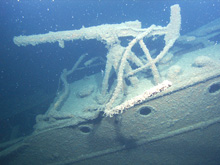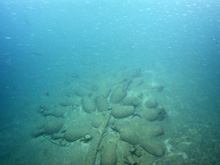
Deck-mounted gun, Destroyer of the Black Sea Fleet, Dzerzhynsky, sunk in 1942. Click image for larger view and image credit.
Black Sea 2006 Expedition Summary
Michael Brennan
Ph.D. Student
Institute for Archaeological Oceanography
Graduate School of Oceanography
University of Rhode Island
The 2006 Black Sea expedition had a number of objectives, including the survey of the shelf and deep water off the Crimean Peninsula for archaeological sites and the identification and imaging in high definition of sites spanning the Classical period through modern times. A few 20th century wrecks, such as the Dzerzhynsky and Lenin, had rough coordinates, which we used to help locate the ships and then document the wrecks’ condition. Additionally, the IFE ROVs Hercules and Argus are equipped with sensors to collect oceanographic data and this expedition looked to use this technology along the northern coast of the Black Sea and along the oxic/anoxic interface.

Cargo wreck containing ceramic jars dating to the 9-11th centuries A.D. found along the trade route between Constantinople and Chersonesos on the Crimean Peninsula. Click image for larger view and image credit.
The R/V Endeavor covered approximately 650 square kilometers of the seafloor with side-scan sonar and subbottom profiling using the IFE towfish, Echo. With these data, we logged a total of 494 targets on the side-scan and also noted a number of features in the profiles, such as submarine river channels on the Black Sea shelf. Sensors on the Hercules ROV collected data during every dive and this provides us with vertical profiles of the oxygen levels across the oxic/anoxic boundary. Dives ranged from shallow depths, just under 100m for the Lenin, to depths over 1600m away from the shelf. The wrecks of the warships Dzherzynsky and Lenin were found and documented with Hercules and a number of other wrecks were also found, including a pre-Dreadnaught warship, Ekaterina, a medieval amphora wreck and three aircraft. The medieval wreck was located above the anoxic water layer and is poorly preserved. The jar types have been roughly dated to the 9th to 11th centuries AD. The Dzherzynsky and Lenin, as well as the Ekaterina, were found in shallower water above 150m depth.
Our sonar survey covered an extensive amount of area in the northern Black Sea along the shelf of the Crimean Peninsula and we logged nearly 500 targets, only 44 of which we were able to return to for identification with the ROVs. Besides the shipwrecks we found, a number of the targets also turned out to be various bits of trash or cable that shows the highly active history of this region. This was some of the first deep water archaeology conducted in the waters near the Crimean Peninsula and along the trade route between the Bosporus Strait and Sevastopol or the ancient site of Chersonesos; the medieval wreck lay directly on this line. Future work will continue to focus on this region in an effort to continue to document this area’s maritime history.
Sign up for the Ocean Explorer E-mail Update List.







